Compression-Induced Tensile Mechanical Behaviors of the Crystalline Rock under Dynamic Loads
Abstract
1. Introduction
2. Materials and Methods
2.1. Sample Preparation and Experimental Procedure
2.2. Numerical Modelling
3. Results
3.1. Experimental Results and the Numerical Model Calibration
3.2. Numerical Results
4. Discussion
5. Conclusions
Author Contributions
Funding
Conflicts of Interest
References
- Rossmanith, H.P.; Daehnke, A.; Nasmillner, R.E.K.; Kouzniak, N.; Ohtsu, M.; Uenishi, K. Fracture mechanics applications to drilling and blasting. Fatigue Fract. Eng. Mater. Struct. 1997, 20, 1617–1636. [Google Scholar] [CrossRef]
- Afeni, T.B. Optimization of drilling and blasting operations in an open pit mine—The SOMAIR experience. Min. Sci. Technol. 2009, 19, 736–739. [Google Scholar] [CrossRef]
- Huang, X.; Qi, S.; Liu, Y.; Zhan, Z. Stress wave propagation through viscous-elastic jointed rock masses using propagator matrix method (PMM). Geophys. J. Int. 2015, 200, 452–470. [Google Scholar] [CrossRef]
- Huang, X.; Qi, S.; Zheng, B.; Liu, Y.; Xue, L.; Liang, N. Stress wave propagation through rock joints filled with viscoelastic medium considering different water contents. Appl. Sci. 2020, 10, 4797. [Google Scholar] [CrossRef]
- Hawkes, I.; Mellor, M.; Gariepy, S. Deformation of rocks under uniaxial tension. Int. J. Rock Mech. Min. Sci. Geomech. Abstr. 1973, 10, 493–507. [Google Scholar] [CrossRef]
- Peng, S.S. A note on the fracture propagation and time-dependent behavior of rocks in uniaxial tension. Int. J. Rock Mech. Min. Sci. Geomech. Abstr. 1975, 12, 125–127. [Google Scholar] [CrossRef]
- Carneiro, F. A New Method to Determine the Tensile Strength of Concrete. In Paper Presented at the Proceedings of the 5th Meeting of the Brazilian Association for Technical Rules; Associação Brasileire de Normas Técnicas—ABNT: Rio de Janeiro, Brazil, 1943. [Google Scholar]
- ISRM. Suggested methods for determining tensile strength of rock materials. Int. J. Rock Mech. Min. Sci. Geomech. Abstr. 1978, 15, 99–103. [Google Scholar] [CrossRef]
- Mahabadi, O.K.; Randall, N.X.; Zong, Z.; Grasselli, G. A novel approach for micro-scale characterization and modeling of geomaterials incorporating actual material heterogeneity. Geophys. Res. Lett. 2012, 39, 1303. [Google Scholar] [CrossRef]
- Mahabadi, O.K.; Tatone, B.S.A.; Grasselli, G. Influence of microscale heterogeneity and microstructure on the tensile behavior of crystalline rocks. J. Geophys. Res. Solid Earth 2014, 119, 5324–5341. [Google Scholar] [CrossRef]
- Hofmann, H.; Babadagli, T.; Yoon, J.S.; Zang, A.; Zimmermann, G. A grain based modeling study of mineralogical factors affecting strength, elastic behavior and micro fracture development during compression tests in granites. Eng. Fract. Mech. 2015, 147, 261–275. [Google Scholar] [CrossRef]
- Duan, K.; Kwok, C.Y. Evolution of stress-induced borehole breakout in inherently anisotropic rock: Insights from discrete element modeling. J. Geophys. Res. Solid Earth 2016, 121, 2361–2381. [Google Scholar] [CrossRef]
- Hallbauer, D.K.; Wagner, H.; Cook, N.G.W. Some observations concerning the microscopic and mechanical behaviour of quartzite specimens in stiff, triaxial compression tests. Int. J. Rock Mech. Min. Sci. Geomech. Abstr. 1973, 10, 713–726. [Google Scholar] [CrossRef]
- Kranz, R.L. Microcracks in rocks: A review. Tectonophysics 1983, 100, 449–480. [Google Scholar] [CrossRef]
- Brace, W.F.; Paulding, B.W.; Scholz, C. Dilatancy in the fracture of crystalline rocks. J. Geophys. Res. Atmos. 1966, 71, 3939–3953. [Google Scholar] [CrossRef]
- Cho, N.; Martin, C.; Sego, D. A clumped particle model for rock. Int. J. Rock Mech. Min. Sci. 2007, 44, 997–1010. [Google Scholar] [CrossRef]
- Eberhardt, E.; Stead, D.; Stimpson, B.; Read, R.S. Identifying crack initiation and propagation thresholds in brittle rock. Can. Geotech. J. 1998, 35, 222–233. [Google Scholar] [CrossRef]
- Fredrich, J.T.; Evans, B.; Wong, T.F. Effect of grain size on brittle and semibrittle strength: Implications for micromechanical modelling of failure in compression. J. Geophys. Res. Solid Earth 1990, 95, 10907–10920. [Google Scholar] [CrossRef]
- Martin, C.D.; Chandler, N.A. The progressive fracture of Lac du Bonnet granite. Int. J. Rock Mech. Min. Sci. Geomech. Abstr. 1994, 31, 643–659. [Google Scholar] [CrossRef]
- Mayer, J.M.; Stead, D. Exploration into the causes of uncertainty in UDEC Grain Boundary Models. Comput. Geotech. 2017, 82, 110–123. [Google Scholar] [CrossRef]
- Wang, Y.; Tonon, F. Modeling Lac du Bonnet granite using a discrete element model. Int. J. Rock Mech. Min. Sci. 2009, 46, 1124–1135. [Google Scholar] [CrossRef]
- Qi, S.; Lan, H.; Martin, D.; Huang, X. Factors controlling the difference in brazilian and direct tensile strengths of the Lac du Bonnet Granite. Rock Mech. Rock Eng. 2020, 53, 1005–1019. [Google Scholar] [CrossRef]
- Blair, S.C.; Cook, N.G.W. Analysis of compressive fracture in rock using statistical techniques: Part II. Effect of microscale heterogeneity on macroscopic deformation. Int. J. Rock Mech. Min. Sci. 1998, 35, 849–861. [Google Scholar] [CrossRef]
- Lan, H.; Martin, C.D.; Hu, B. Effect of heterogeneity of brittle rock on micromechanical extensile behavior during compression loading. J. Geophys. Res. Solid Earth 2010, 115, B0112. [Google Scholar] [CrossRef]
- Dai, F.; Xia, K. Loading rate dependence of tensile strength anisotropy of barre granite. Pure Appl. Geophys. 2010, 167, 1419–1432. [Google Scholar] [CrossRef]
- Wu, B.; Yao, W.; Xia, K. An Experimental study of dynamic tensile failure of rocks subjected to hydrostatic confinement. Rock Mech. Rock Eng. 2016, 49, 3855–3864. [Google Scholar] [CrossRef]
- Dai, F.; Huang, S.; Xia, K.; Tan, Z. Some fundamental issues in dynamic compression and tension tests of rocks using split hopkinson pressure bar. Rock Mech. Rock Eng. 2010, 43, 657–666. [Google Scholar] [CrossRef]
- Dai, F.; Wei, M.D.; Xu, N.W.; Ma, Y.; Yang, D.S. Numerical assessment of the progressive rock fracture mechanism of cracked chevron notched brazilian disc specimens. Rock Mech. Rock Eng. 2015, 48, 463–479. [Google Scholar] [CrossRef]
- Wong, L.N.Y.; Zou, C.; Cheng, Y. Fracturing and failure behavior of carrara marble in quasistatic and dynamic brazilian disc tests. Rock Mech. Rock Eng. 2014, 47, 1117–1133. [Google Scholar] [CrossRef]
- Cundall, P.A. A computer model for simulating progressive large-scale movements in blocky rock systems. In Proceedings of the Symposium of the International Society for Rock Mechanics, Nancy, France, 4–6 October 1971; Volume 1. [Google Scholar]
- UDEC (Universal Distinct Element Code), Version 6.0; Itasca: Minneapolis, MN, USA, 2014.
- Parteli, E.J.R.; Schmidt, J.; Blümel, C.; Wirth, K.E.; Peukert, W.; Pöeschel, T. Attractive particle interaction forces and packing density of fine glass powders. Sci. Rep. 2014, 4, 6227. [Google Scholar] [CrossRef]
- Nguyen, D.H.; Azéma, E.; Radjai, F.; Sornay, P. Effect of size polydispersity versus particle shape in dense granular media. Phys. Rev. E 2014, 90, 012202. [Google Scholar] [CrossRef]
- Bass, J. Elasticity of minerals, glasses, and melts. Miner. Phys. Crystallogr. A Handb. Phys. Constants 1995, 2, 45–63. [Google Scholar]
- Xia, K.; Nasseri, M.H.B.; Mohanty, B.; Lu, F.; Chen, R.; Luo, S.N. Effects of microstructures on dynamic compression of Barre granite. Int. J. Rock Mech. Min. Sci. 2008, 45, 879–887. [Google Scholar] [CrossRef]
- Li, D.; Wong, L.N.Y. The brazilian disc test for rock mechanics applications: Review and new insights. Rock Mech. Rock Eng. 2013, 46, 269–287. [Google Scholar] [CrossRef]
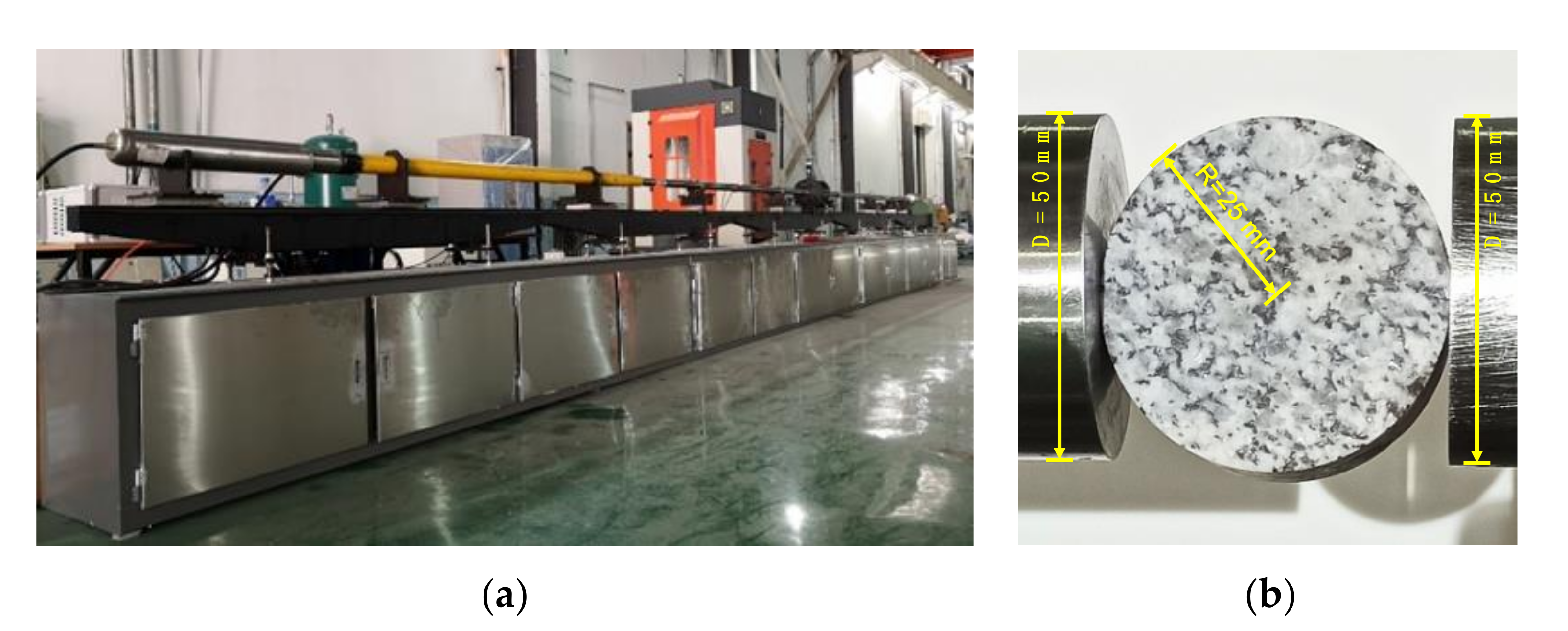

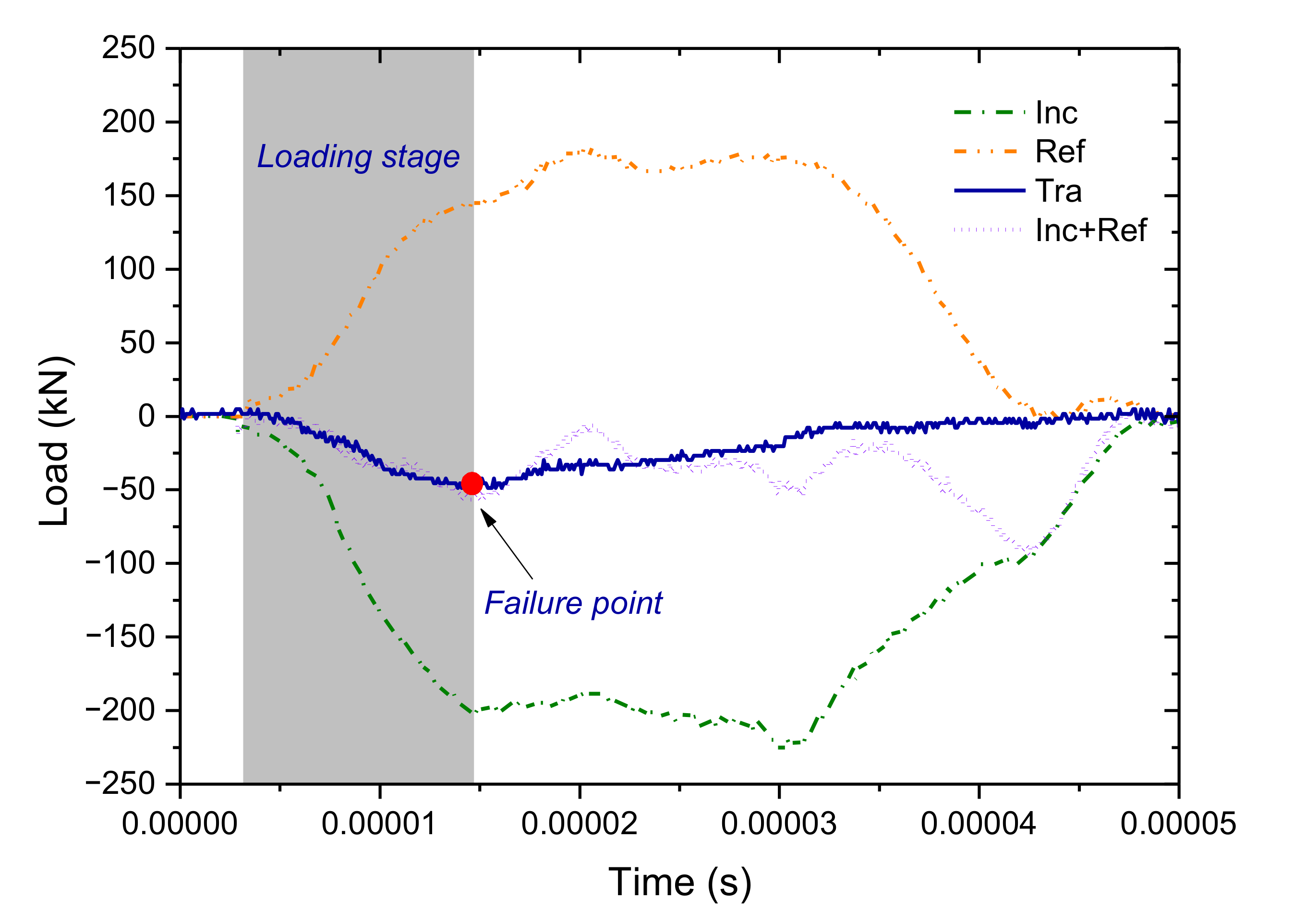
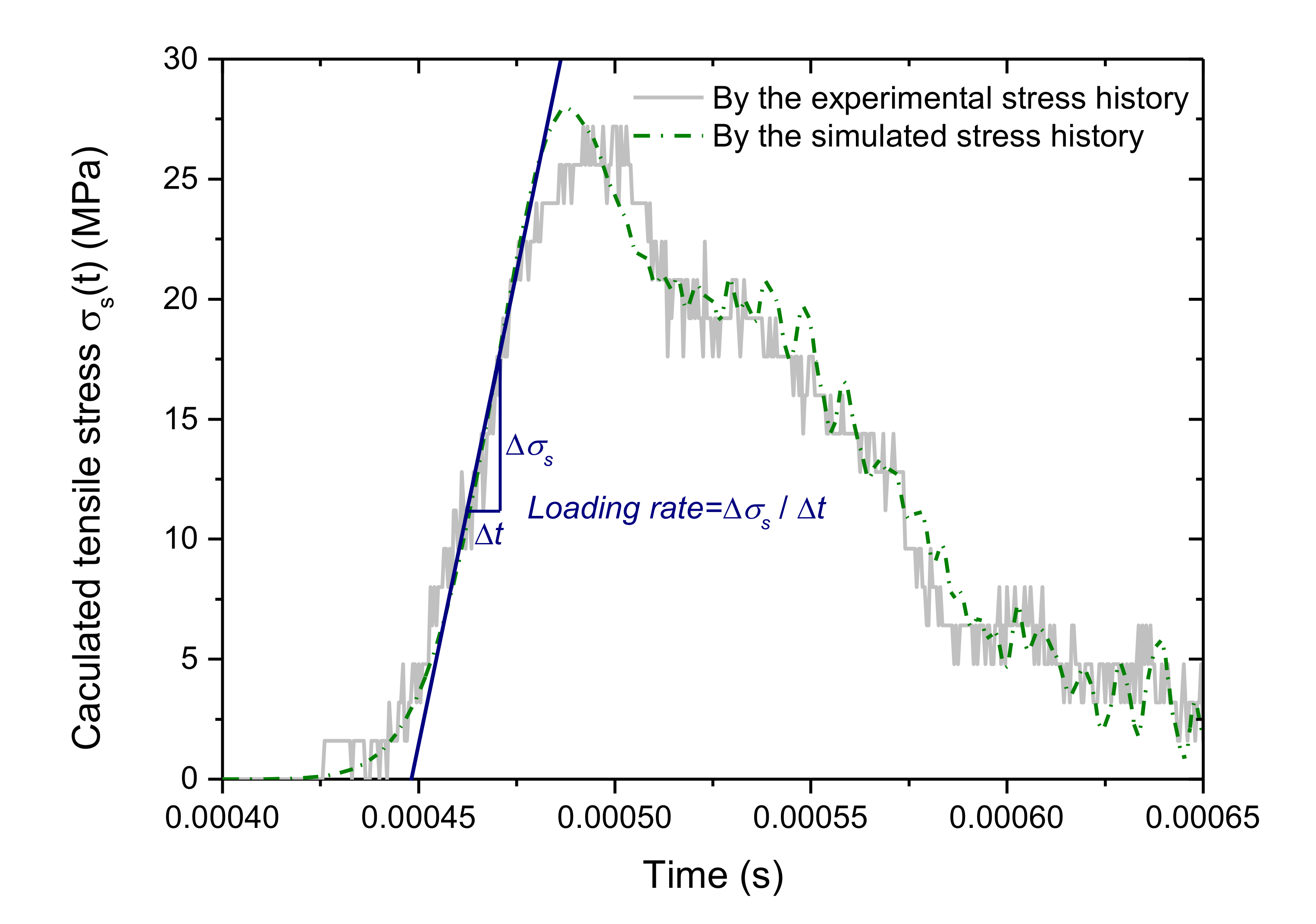
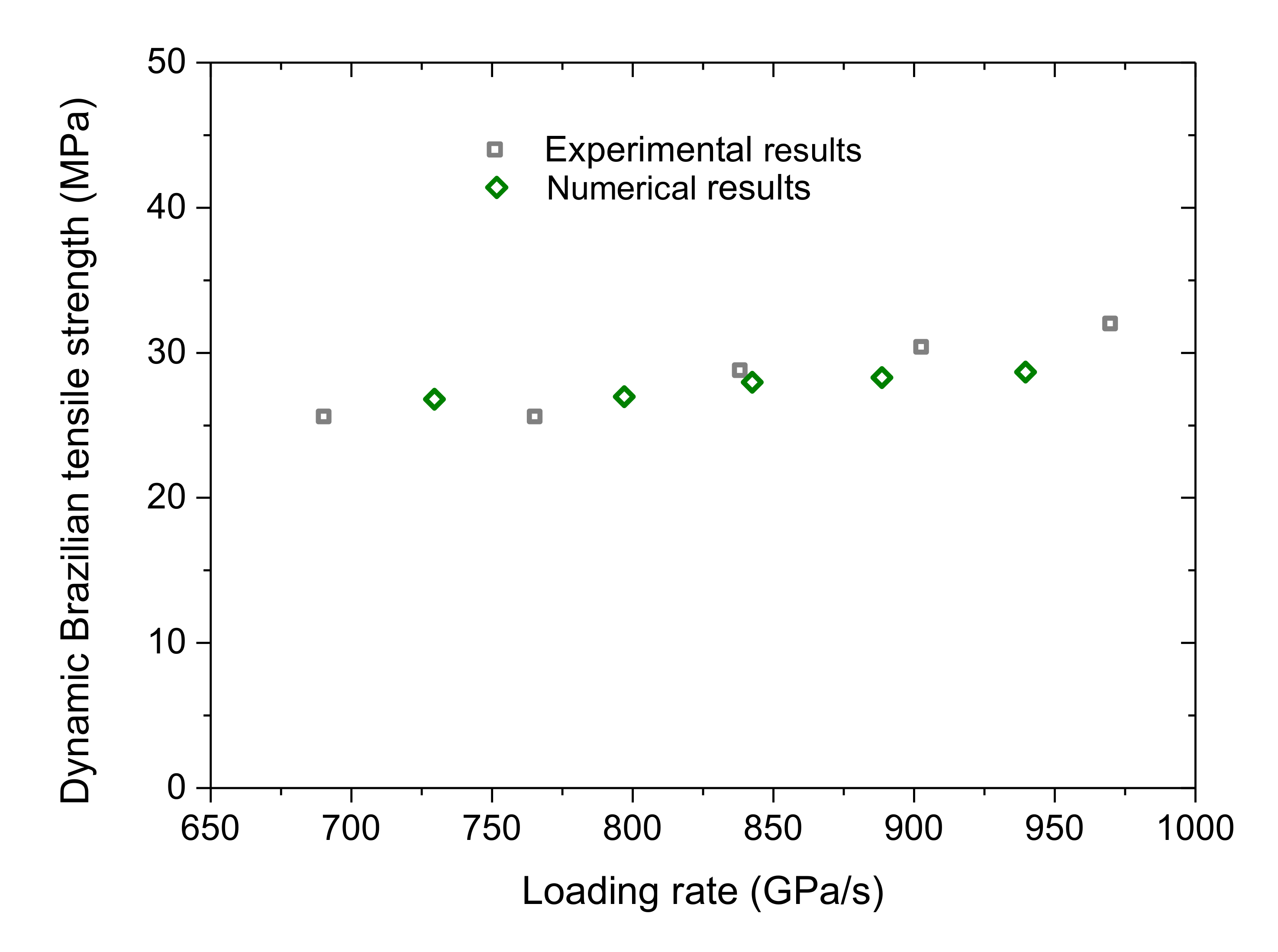
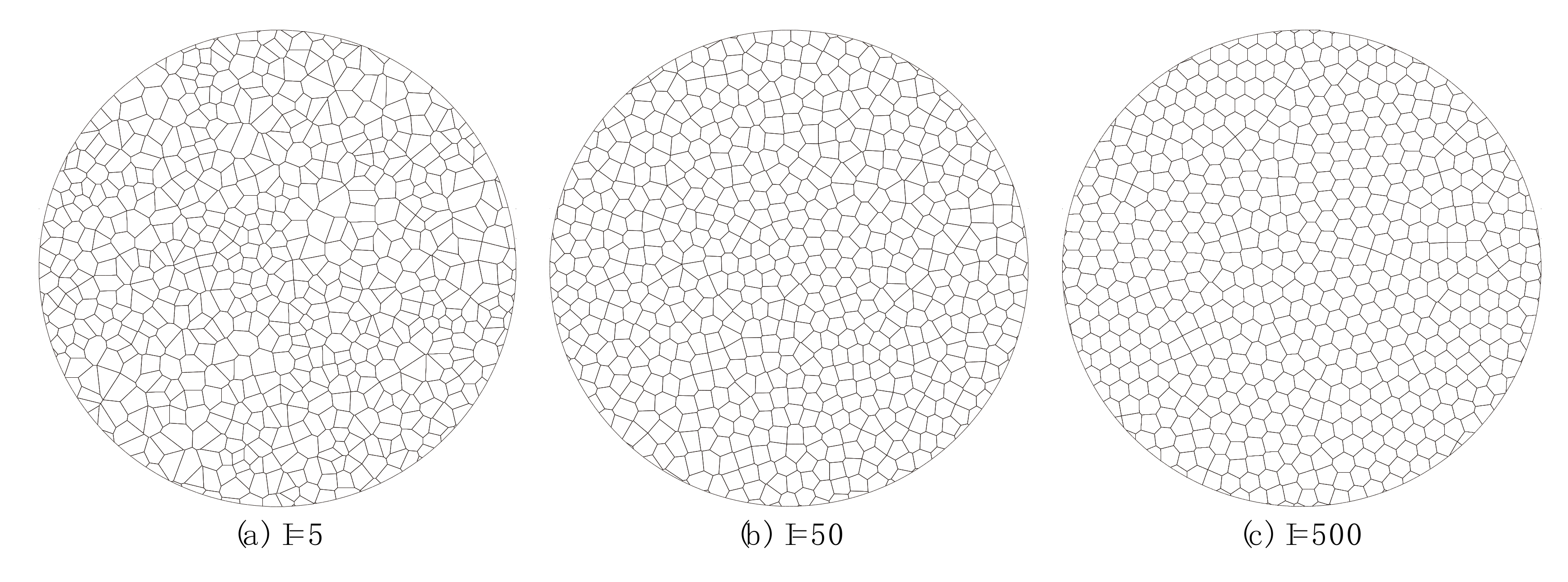
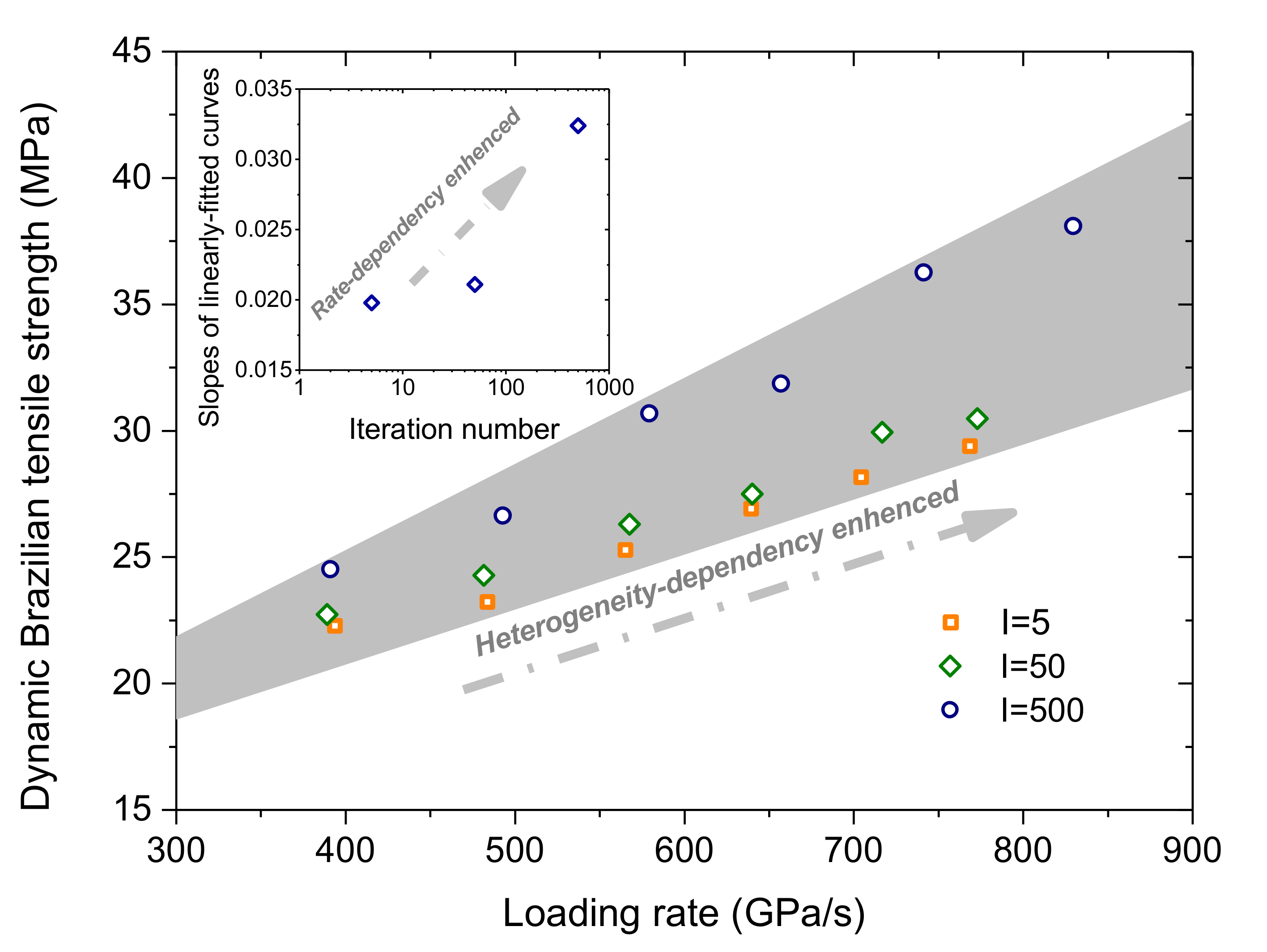
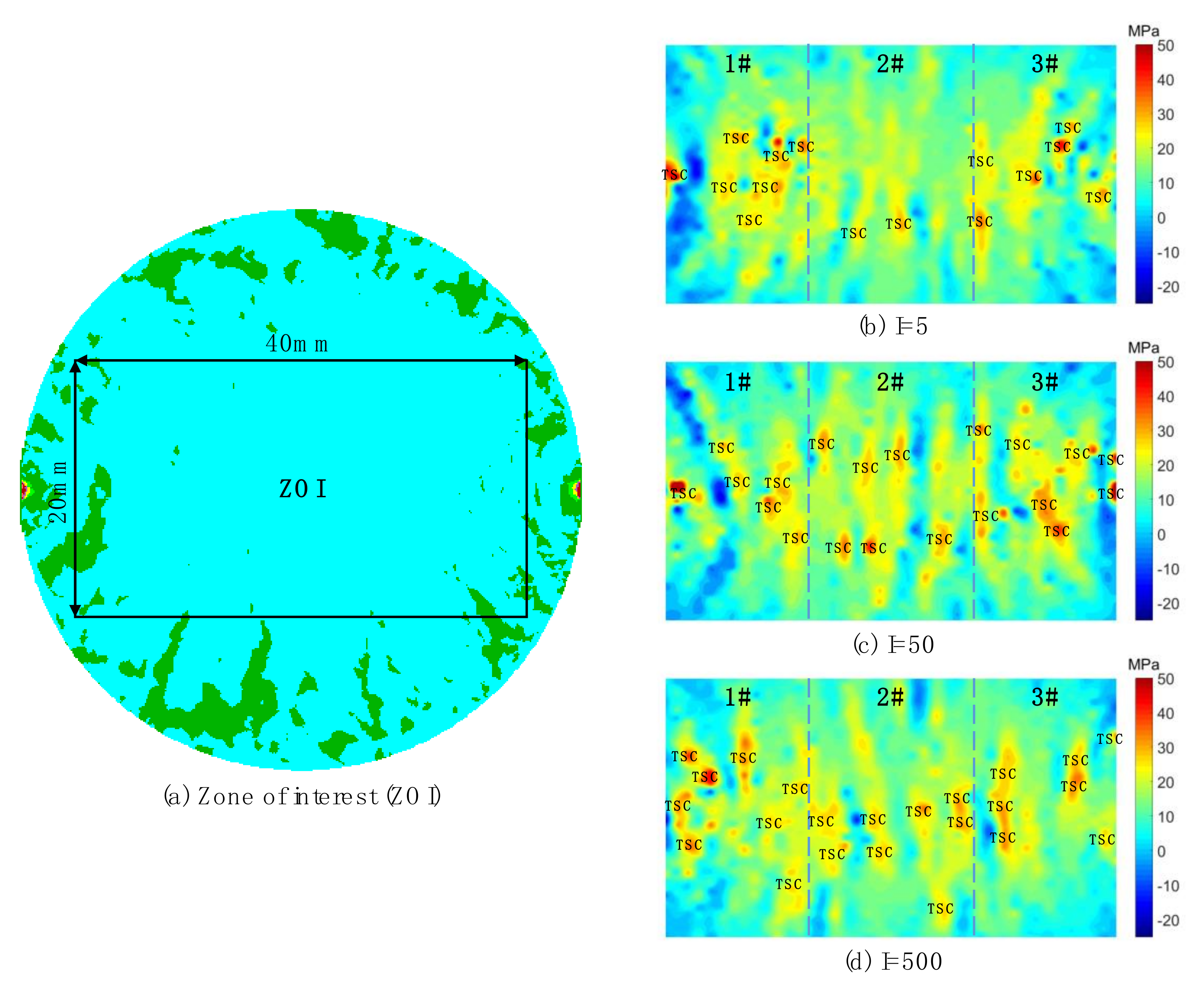

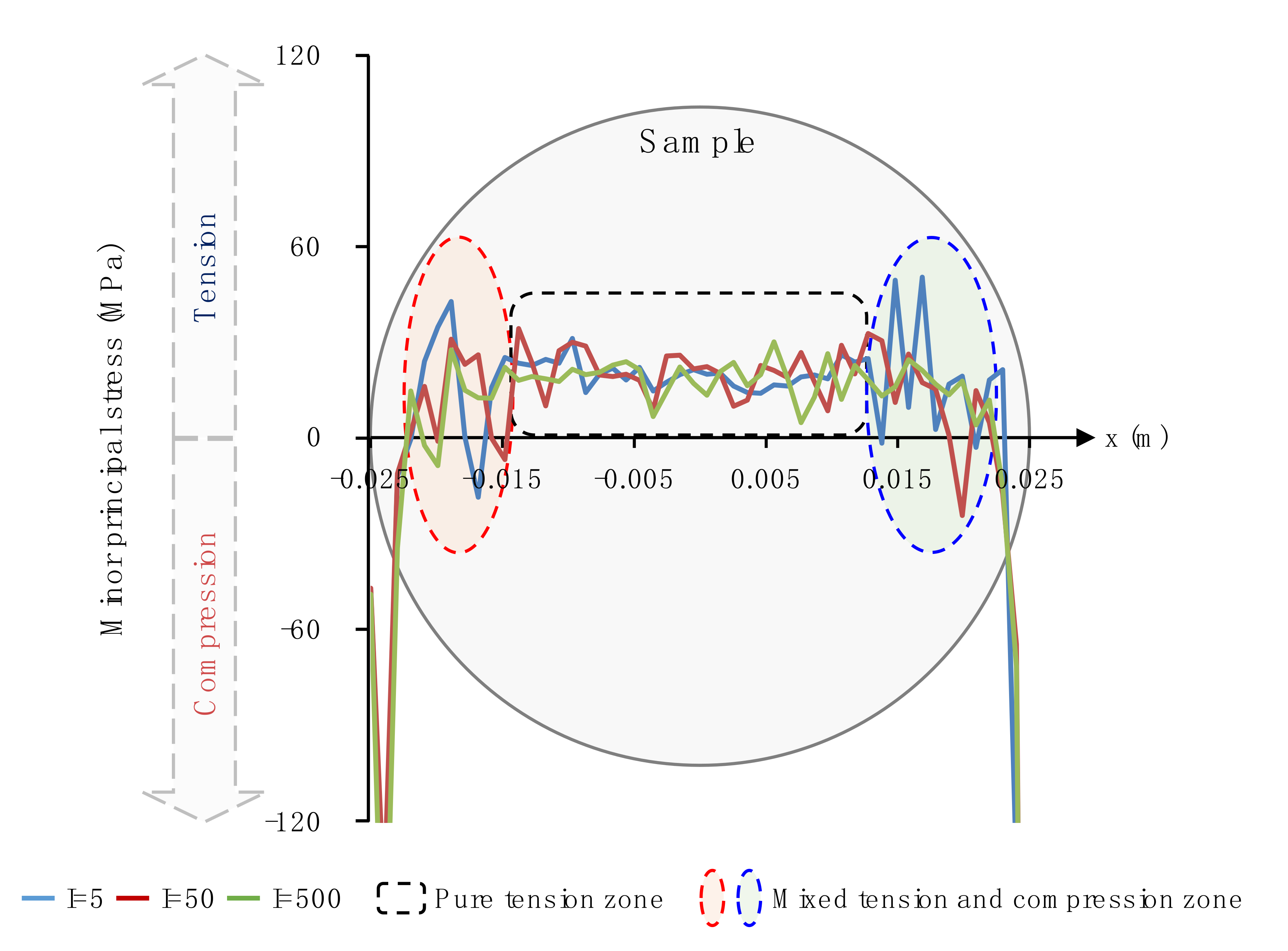
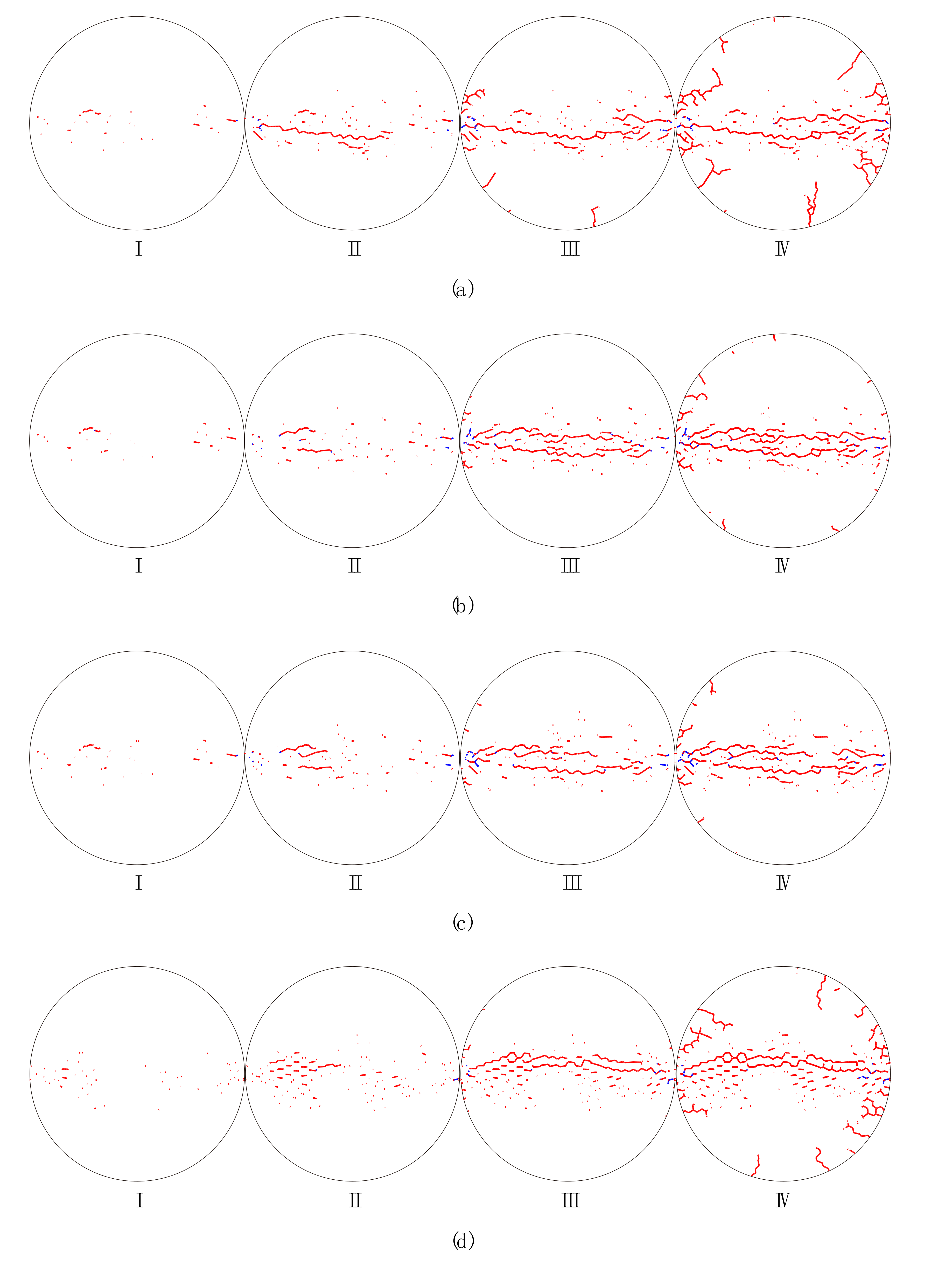
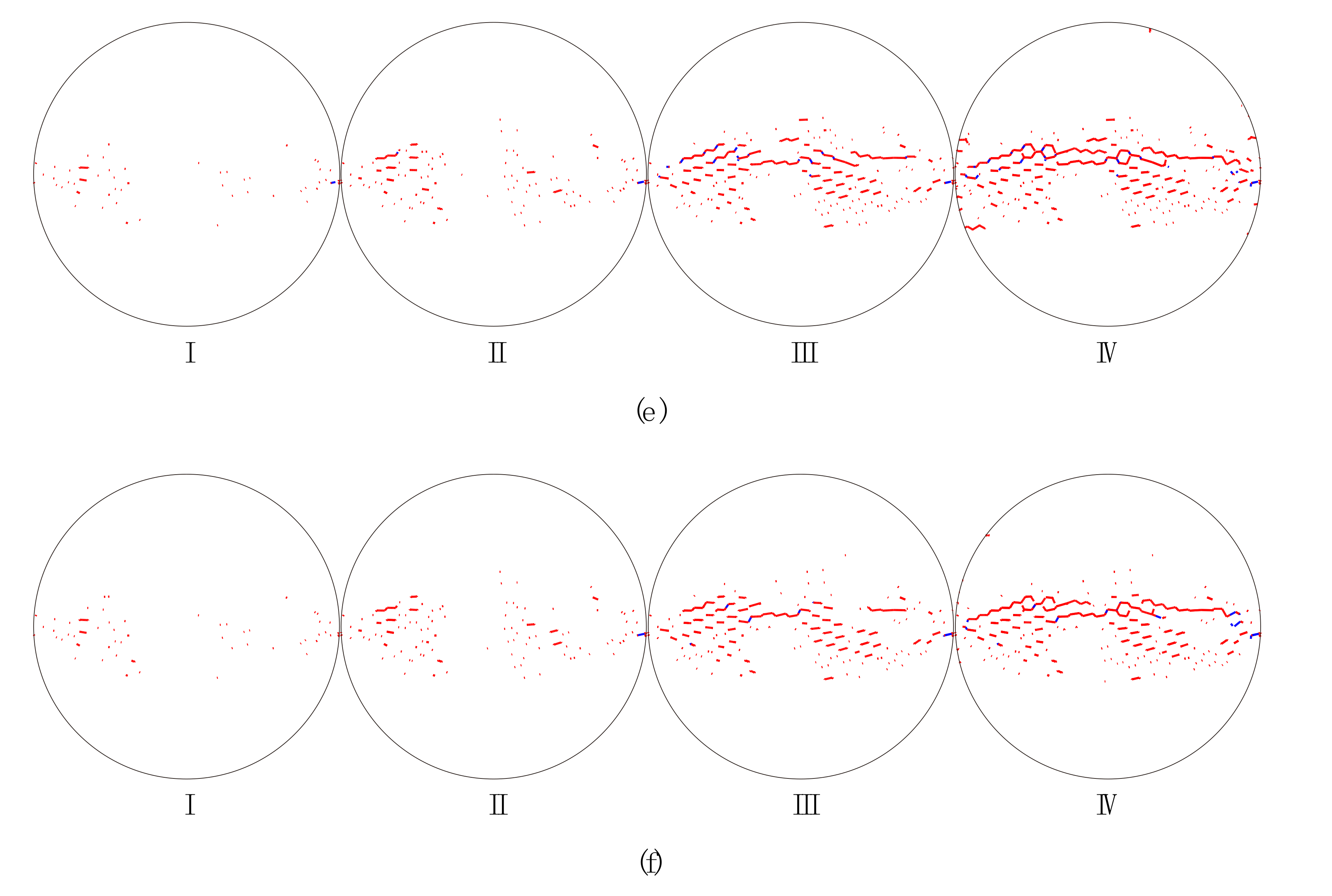
| Mineral Type | Actual (%) | Synthetic (%) | Error (%) |
|---|---|---|---|
| K-feldspar | 40.0 | 40.1 | +0.25 |
| Quartz | 25.0 | 24.9 | −0.40 |
| Plagioclase | 30.0 | 30.0 | 0.0 |
| Biotite | 5.0 | 5.0 | 0.0 |
| Mineral Type (Bar) | Density (g/cm3) | Elastic Modulus E and (K, G) 1 (GPa) | Poisson’s Ratio |
|---|---|---|---|
| K-feldspar | 2.56 | 69.8 (53.7, 27.2) | 0.28 |
| Quartz | 2.65 | 94.5 (37, 44) | 0.08 |
| Plagioclase | 2.63 | 88.1 (50.8, 29.3) | 0.26 |
| Biotite | 3.05 | 33.8 (41.1, 12.4) | 0.36 |
| Steel bar | 7.90 | 184.4 (140, 72) | 0.28 |
| Parameters | Grain Contact | Sample-Bar Contact |
|---|---|---|
| kn (Pa/m) | 5.0 × 1014 | 5.0 × 1014 |
| ks (Pa/m) | 2.5 × 1014 | 2.5 × 1014 |
| T (MPa) | 43.0 | 0 |
| c (MPa) | 120.0 | 0 |
| φ (°) | 27.0 | 0 |
Publisher’s Note: MDPI stays neutral with regard to jurisdictional claims in published maps and institutional affiliations. |
© 2020 by the authors. Licensee MDPI, Basel, Switzerland. This article is an open access article distributed under the terms and conditions of the Creative Commons Attribution (CC BY) license (http://creativecommons.org/licenses/by/4.0/).
Share and Cite
Zheng, B.; Qi, S.; Huang, X.; Liang, N.; Guo, S. Compression-Induced Tensile Mechanical Behaviors of the Crystalline Rock under Dynamic Loads. Materials 2020, 13, 5107. https://doi.org/10.3390/ma13225107
Zheng B, Qi S, Huang X, Liang N, Guo S. Compression-Induced Tensile Mechanical Behaviors of the Crystalline Rock under Dynamic Loads. Materials. 2020; 13(22):5107. https://doi.org/10.3390/ma13225107
Chicago/Turabian StyleZheng, Bowen, Shengwen Qi, Xiaolin Huang, Ning Liang, and Songfeng Guo. 2020. "Compression-Induced Tensile Mechanical Behaviors of the Crystalline Rock under Dynamic Loads" Materials 13, no. 22: 5107. https://doi.org/10.3390/ma13225107
APA StyleZheng, B., Qi, S., Huang, X., Liang, N., & Guo, S. (2020). Compression-Induced Tensile Mechanical Behaviors of the Crystalline Rock under Dynamic Loads. Materials, 13(22), 5107. https://doi.org/10.3390/ma13225107





